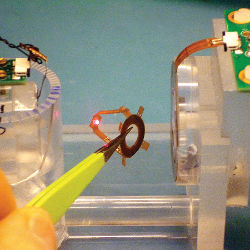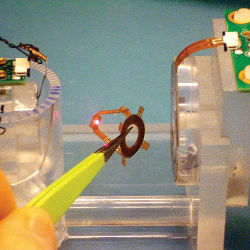
Most wireless communication technology in use today remains firmly tethered to a very 20th-century constraint—the need for a robust, reliable and cost-efficient source of power. Indeed, common mobile devices such as cellphones, tablets, and even electric vehicles are still somewhat limited in terms of the amount of time they can operate without needing to be recharged.
As a result, efforts are under way to develop wireless technology that can either generate electricity seemingly from thin air, or utilize inductive transmission to provide a “last mile” of electricity transmission without the use of wires or advanced battery technology.
Battery technology is advancing, providing longer runtimes. However, in some cases it is impractical to use batteries to power devices, due to the vast number that may need to be replaced. For example, in large commercial or industrial buildings, networked sensors, controllers, and switches are being installed to better monitor and control lighting, HVAC, and other critical building systems. While traditional systems simply ran two sets of wires to each networked device (one to carry power and the other to carry data), fully battery-less and wireless systems can be installed with far lower labor costs, as well as reduced maintenance costs.
A primary example of this type of technology was created by EnOcean GmbH, an Oberhaching, Germany-based firm which created the technology bearing its name. The EnOcean technology allows a device to be self-powered by harvesting the energy generated as a result of the device’s operation. For example, an EnOcean light switch can harvest the kinetic energy generated when the physical switch moves from on to off or back again, creating enough energy to send small bits of data via a wireless radio link.
Similarly, an EnOcean daylight occupancy sensor can harvest ambient energy (heat) and convert it to a tiny electrical charge that will power the sensor, allowing it to send small bits of data across the network.
The greatest benefit to these devices is the ability to have a self-sustaining network of devices that do not need a hard-wired power source (which costs significantly more to install, due to the high cost of labor to string wires around a room or building), and eliminates the need for hundreds or even thousands of batteries for a network of devices, which would need to be changed every few years (a significant recurring labor cost).
Despite the added convenience and operational cost savings provided by these devices, the initial per-device unit costs are anywhere from 10 to 15 times higher than traditional wired devices, and EnOcean technology has caught on primarily in Europe, rather than in North America. However, cost is not the reason for the low rate of adoption in the U.S., says Jonathan Collins, an analyst with ABI Research, based in Oyster Bay, NY.
“Price is not the primary hurdle; the issue is around familiarity and reliability,” Collins says, noting that EnOcean and other wireless energy-harvesting technologies have not yet demonstrated the long track record of successful implementation that is usually required by building architects, engineers, and operators.
Still, the use of naturally occurring energy is not limited to building sensors. Advanced research into the harvesting and use of ambient radio frequency (RF) waves to send data and provide power to a device is under way at the University of Washington (UW).
Researchers in UW’s Department of Computer Science and Engineering’s Networks and Wireless Lab have devised a way for devices to communicate by repurposing television broadcast signals, using a technology called ambient backscatter. The technology works by equipping a device with a hardware receiver that consists of a pair of antennae that look very similar to an old “rabbit ears” television antenna, and a transistor designed to connect the two antennae together. The antenna assembly is then connected to a power harvester tuned to capture or scatter UHF TV signals in a 50MHz-wide frequency band centered at 539MHz.
The receiver does double duty; it allows ambient RF energy to be harvested, and uses that energy to provide the power required to transmit small bits of binary data via RF signals, which can be absorbed by other receivers. Data can either be sent (when each antenna is set to work independently, thereby reflecting or “backscattering” ambient RF signals) or received (when the antennae are set to work in tandem, which permits the efficient absorption of ambient RF signals.)
Data is encoded and sent based on the binary pattern created by the switching between the absorbing and scattering of the ambient waves. The greatest benefit, however, is that the technology does not need a separate power source; the electronics and software use the energy created whenever the antenna is set to absorb radio waves, rather than requiring batteries or a hard-wired power source.
“All this communication is powered by harvesting the energy from the signals themselves,” says Shyamnath Gollakota, a research team member and assistant professor at UW. The technology is “transforming these existing ambient signals into both a source of power and also a communication medium that you can piggyback onto these signals and transfer information.”
“There has to be a single standard, and as long as there are other groups trying to develop their own standards … it is confusing.”
So far, prototypes have been able to send a very limited amount of data—roughly one kilobit per second—at a distance of up to about three feet, according to Gollakota. He expects the next iteration of the technology will expand that range to about 12 to 20 feet. In addition. Gollakota says his group is expanding the technology to utilize ambient backscatter with cellular signals, which generally operate at frequencies above 1GHz, compared to the 500MHz signals found in television broadcast signals.
Gollakota sees a future use for the technology in applications where low-cost and low-power data transfer is more important than high data-rate transfers, such as a replacement for RFID tags. Devices equipped with this technology could communicate with a head-end reader or other tagged devices by leveraging existing ambient Wi-Fi or cellular signals, instead of having to set up a separate powered network of RFID readers. Furthermore, the limited amount of power that is able to be harvested from RF sources is unlikely to be useful for items that require large or constant sources of power, such as recharging batteries.
Scientists do not expect to see this technology in commercial use in the near future. Gollakota says the technology is only in prototype phase—with limited range and data throughput—and security issues have yet to be addressed.
Still, battery technology—and the creation of adjacent technologies designed to further the usability of battery-based devices—remains a key area of focus, particularly for devices that require continuous power, such as handheld personal devices and electric vehicles.
Wireless induction technology is currently being utilized to provide a more convenient way to recharge personal devices, with the end goal being a worldwide or regional standardized method for easily charging any device without requiring a physical plug-to-device link.
Wireless induction charging utilizes the underlying technology developed by Nikola Tesla and others more than 100 years ago. Power is transmitted from a charging pad to a portable electronic device via electromagnetic waves, typically using an induction coil to create an alternating electromagnetic field from within a charging base station. A second coil, located inside the device, converts the electromagnetic field back into electrical current to charge the device’s battery.
Competing technical approaches are in use, and in development. In 2012, the Power Matters Alliance (PMA) announced it was developing an open standard for inductive coupling technology, known as IEEE P2100.1. Meanwhile, the Wireless Power Consortium (WPC) has developed its own competing international standard, known as Qi (pronounced “Chi”), an open standard designed to promote interoperability between wireless devices and charging stations.
“There has to be a single standard, and as long as there are other groups trying to develop their own standards—in many cases, very similar standards—it is confusing,” says John Perzow, vice president of market development for the Wireless Power Consortium. The lack of an international standard “will delay the adoption of this technology.”
Induction is also being used on a much larger scale, to provide ongoing wireless charging of city buses in Gumi, South Korea. In this test setting, a wireless induction system from the Korea Advanced Institute of Science and Technology (KAIST) utilizes 180kW power strips embedded along a road that can create a magnetic field above them, which can be used to wirelessly transfer energy to a receiver underneath a bus. In this system, the strips in the road create the magnetic field, and a receiver located underneath the bus converts the magnetic field back into an electric current, which flows to the battery and motor, powering the bus. The power strip is switched on only when a bus is approaching or departing based on a proximity sensor, eliminating the possibility that a power strip will create a magnetic field when regular vehicles pass above it.
The buses receive up to 85% of the power generated by passing the receiver through the magnetic field, enabling the buses to use onboard batteries about one-third the size of a typical car battery, reducing the system’s weight and cost. Charging takes place while the buses are being driven along their routes, eliminating downtime that would be required using traditional electric vehicle charging technology, while also reducing the vehicle emissions that are common with traditional internal combustion engines.
The challenge in bringing this technology to scale is based on the cost of the in-road infrastructure. Although KAIST claims the technology will only require 5% to 15% of an existing stretch of road to be rebuilt, Dong-Ho Cho, one of the main researchers involved with the project, admits that reducing the number of power strips in the road could impact performance and require larger batteries, eliminating the advantages of this system.
Cho notes that for the Gumi 7.5-mile test road, six power strips were installed at a cost of $1.2 million, and the receiver included on each bus cost $500,000, which indicates the commercial implementation of this technology may be a hard sell, particularly for cash-strapped municipalities that generally own and operate the majority of roads around the world.
Nevertheless, the concept of wireless induction charging has been proven in the Italian cities of Turin and Genoa. For the last 10 years, electric buses that use stationary induction charging (at the depot and via charging coils located under bus stops) have been used successfully, resulting in a system that provided economic payback of the initial investment in just four years. The major difference between these systems and the one proposed by KAIST is that the South Korean system allows buses to be charged while moving, instead of being charged while stopped.
For Further Reading
Liu, V., Parks, A., Talla, V., Gollakota, S., Wetherall, D., Smith, J.
“Ambient Backscatter: Wireless Communication Out of Thin Air,” University of Washington, http://abc.cs.washington.edu/files/comm153-liu.pdf
Charging by Induction, The Physics Classroom, http://www.physicsclassroom.com/class/estatics/u8l2b.cfm
“KAIST’s wireless Online Electric Vehicle, OLEV, runs inner city roads,” Korea Korea Advanced Institute of Science and Technology (KAIST), http://www.eurekalert.org/pub_releases/2013-08/tkaikwo080513.php
EnOcean Technology – Energy Harvesting Wireless, EnOcean GmbH, at http://www.enocean.com/fileadmin/redaktion/pdf/white_paper/WP_EnOcean_Technology_en_Jul11.pdf
Video
University of Washington- Ambient Backscatter: http://www.youtube.com/watch?v=gX9cbxLSOkE
KAIST OLEV Vehicle Demonstrations: http://www.youtube.com/watch?v=BbzkzOmwgdY
Figures
 Figure. Researchers at the Victorian Research Laboratory of NICTA, Australia’s Information Communications Technology Research Centre of Excellence, test the provision of power wirelessly to a planar spiral coil.
Figure. Researchers at the Victorian Research Laboratory of NICTA, Australia’s Information Communications Technology Research Centre of Excellence, test the provision of power wirelessly to a planar spiral coil.
 Figure. Using inductive coupling, power is transferred from a primary coil (center) to a secondary coil in a compatible device, eliminating the need for power cords to charge the device.
Figure. Using inductive coupling, power is transferred from a primary coil (center) to a secondary coil in a compatible device, eliminating the need for power cords to charge the device.




Join the Discussion (0)
Become a Member or Sign In to Post a Comment